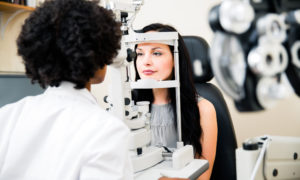By James E. Grue, OD,
and Ronald P. Snyder, OD, FAAO

Nov. 4, 2020
Part two of a three-part series on the 21st Century Cures Act.
The 21st Century Cures Act is a new law with implications for how you practice optometry. Here are important ways this legislation will impact your practice.
In part one of this article, we discussed the background of the 21st Century Cures Act and some of its implications, in particular, how the law will support a significant expansion of clinical research. This article will discuss how this new law will affect your practice, and explain the preparations you need to make to comply with the new information-blocking rules. We also will explain how payers will be able to use the law; introduce the concept of “The World of Apps”; and look at how clinical outcome analytics are going to become more important and relevant to your clinical decision-making.
The following is an excerpt from the Final Rule of the 21st Century Cures Act, which goes into effect on December 31, 2020, that guides the elimination of information blocking:
Until the date specified in 45 CFR 171.103(b), an actor must respond to a request for access, exchange, or use of EHI with, at a minimum, all of the EHI that they have that corresponds to any of the data elements represented in the United States Core Data for Interoperability (USCDI) standard adopted in 45 CFR 170.213. After the date specified in 45 CFR 171.103(b), an actor must respond to a request for access, exchange, or use of EHI with, at a minimum, all of the information they have that is EHI as defined in 45 CFR 171.102.
In this excerpt there are many implications for health-care providers.
Provide the Electronic Health Information Contained in EHR to Patients Who Request It
First, the law grants access to all electronic health information (EHI). In other words, you must provide access to everything that you have documented during each patient visit. You must provide, according to the patient’s request, access to the actual electronic health information that is contained in your EHR. Currently, many providers rely primarily on faxes to communicate between providers. Faxes, PDFs and Word documents, are not electronic documents. They require a human being to send and read these documents to use the information contained within them. The purpose of the 21st Century Cures Act is to share EHI, so these shared documents can be read by computers and the data can be used in automated ways to dramatically improve efficiency.
Better information sharing will allow patient health information to be electronically moved to where it is needed, when it is needed.
By the end of December 2020, you must be able to provide electronic access to all of the EHI that is included in the United States Core Data for Interoperability (USCDI). Click HERE for a description of all of the elements in the USCDI. The data in this link includes patient demographics, vital signs, problem list, medication list, care team members and the plan of care. It also includes all of your clinical notes.
The most immediate threat comes from eyeglass and contact lens online retailers. With permission from your patient, these retailers will be able to access your EHR and get your patient’s final spectacle and contact lens prescriptions.
On the flip side, you will now have access to your patients’ health information from their previous medical and eyecare providers. Think of how much more you will know about your patients with this information. This hasn’t happened by coincidence, as the purpose of this law is to facilitate providers to work more efficiently and more cooperatively as a “team.” Being able to share this information makes that possible. This also brings a level of efficiency to your practice that has not previously been available to independent providers.

To learn more: 844.393.3282. (toll free) or ContactUs@HealthCareRegistries.com
Eliminate Use of Faxes & Start Using Your EHR’s Communications Tools
For a new patient, your EHR can electronically receive their previous records and with a single click, import the data directly into the patient’s chart. From a practical basis, every health-care provider should eliminate the use of faxes and learn how to use the electronic communications that is already built into your certified EHR. Sounds like a big change, but this efficiency gives you time to see more patients with much less administrative burden. It is important to ensure that you update your EHR to its latest software version. Some older versions of software are likely antiquated and do not have the capability to meet these new regulations. This could subject you to the financial penalties associated with information blocking.
Create Strategy to Counter Impact of Online Retailers Accessing Patient Prescriptions
If the success of your practice is dependent on optical sales, you need to begin strategizing how to effectively counter the potential impact that the new level of access by online retailers will have on your optical and contact lens business. Some providers are already developing innovative and effective strategies to counter these changes. If you continue to operate as normal, most likely you will find it more difficult to compete.
Prepare for Increase in Electronic Audits
Payers have always had access to your financial data. The new law now gives them access to clinical data as well. It is probable that there will be a significant increase in electronic audits and a significant decrease in the physical audits that require you to make copies of your patient records and send them to payers.
Plan to Demonstrate Improved Clinical Outcomes
The law will begin moving payers toward true value-based care reimbursements. The Affordable Care Act put in place a unique process to decrease the cost of care. There have been many previous cost-cutting efforts, including the advent of health-care management organizations (HMOs) and other similar plans. The current health-care reform process is based on the recognition of one reality, that is, “the best care is the lowest cost care.” It is based on a two-step process. The first step is to measure clinical outcomes that occur from the care provided and to pay incentives to providers who consistently deliver the care that results in the best outcomes. The second step is to eliminate costs that do not contribute to improved care. Those two steps should result in a delivery system that delivers the best value.
Other Articles to Explore
Expect to see the trend continue where payers increasingly establish provider panel participation to those providers who demonstrate improved clinical outcomes and avoid unnecessary costs that would increase the cost of care without improving outcomes. The best example is a patient referred by one provider to another provider for specialized care. Diagnostic tests that have already been done, but not included in the referral, creates unnecessary redundancy if they have to be repeated. The 21st Century Cures Act requires every certified EHR to have the ability to easily share test results. Your protocols with providers to whom you refer should consider these cost issues as it may limit the ability of both practices to participate on provider panels.
Get Ready for the “World of Apps”
The 21st Century Cures Act, which was enacted to stop information blocking, is releasing what is referred to as “The World of Apps.” Disruptive technology with new players to healthcare are looking at health-care issues with a new strategy. A good example was presented at last year’s Annual Meeting of Office of National Coordinator (ONC). One of the participants, Google, looked at childhood asthma to determine if it could help reduce the rate of hospitalizations. The best experts in medicine felt that until new medications became available, there was nothing else that could be done to reduce the rate of hospitalizations. They believed that they were already delivering the best care available.
Google developed an app for smartphones which monitored inhaler doses, air quality, temperature and humidity. The app was able to alert the patient’s provider to the adverse effects that were happening. The result was a 95 percent reduction in hospitalizations without the use of any new medications. This is a perfect example of how players, who are not locked into traditional health-care thinking, can develop innovative approaches that significantly affect care. The hope is that this type of thinking will be stimulated throughout medicine and that new players will emerge to combine technology and data in innovative ways to advance health-care delivery.
Figure Out the Logistics & Get Ready to Put Into Action Tracking of Clinical Outcomes
The elimination of information blocking enacted by the 21st Century Cures Act is likely to have its biggest influence on the ability to measure clinical outcomes. In the past, information blocking by EHRs has significantly limited the ability to measure and analyze clinical outcomes – but that stops with this law. Currently, the majority of eyecare providers do not track any clinical outcomes. That is expected to rapidly change as clinical outcomes’ analytics become the basis for improving clinical decision-making for both the patient and the provider. This topic is extremely important, which is why the next article in this series will be dedicated to clinical outcome data.
This next article will provide examples of clinical outcomes’ data, how it is being used, and what to expect in the future. It will demonstrate how the power of clinical outcomes’ data will improve the quality of care you can deliver. It will also show the marketing advantage that this data brings, giving you innovative ways to build your practice.
 James E. Grue, OD, is a health-care reform speaker and consultant. To contact him: JimGrue@HealthCareRegistries.com
James E. Grue, OD, is a health-care reform speaker and consultant. To contact him: JimGrue@HealthCareRegistries.com
 Ronald P. Snyder, OD, FAAO, is the president and CEO of HealthCare Registries, LLC. To contact him: RonSnyder@HealthCareRegistries.com
Ronald P. Snyder, OD, FAAO, is the president and CEO of HealthCare Registries, LLC. To contact him: RonSnyder@HealthCareRegistries.com

























